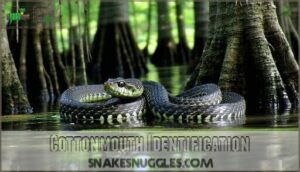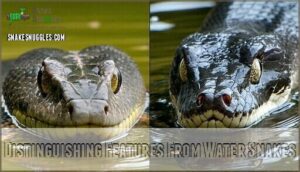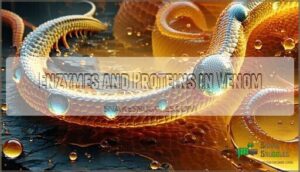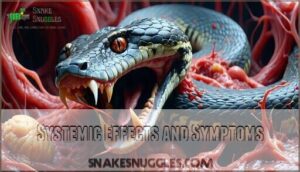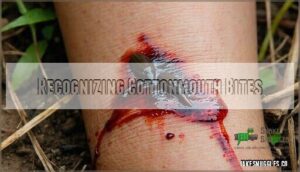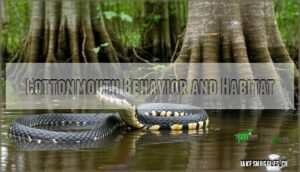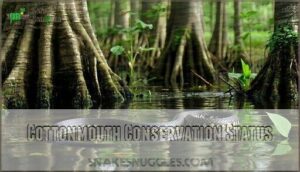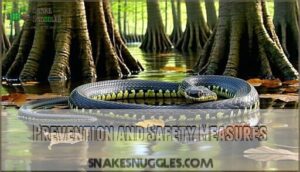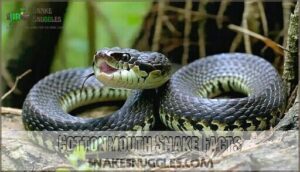This site is supported by our readers. We may earn a commission, at no cost to you, if you purchase through links.
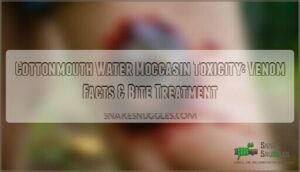 Cottonmouth water moccasin toxicity primarily causes local tissue damage rather than life-threatening systemic effects.
Cottonmouth water moccasin toxicity primarily causes local tissue damage rather than life-threatening systemic effects.
You’ll experience intense pain, swelling, and bruising around the bite site as the venom’s enzymes break down cellular membranes.
Unlike what many people fear, systemic complications and blood clotting problems are actually uncommon with cottonmouth bites.
The venom triggers significant inflammation, making the affected area swell considerably.
Most symptoms remain localized to the bite area, though you might feel nauseous or dizzy.
While cottonmouth bites aren’t usually fatal, they still require immediate medical attention for proper wound care and monitoring.
Understanding the specific signs and proper treatment protocols can make all the difference in recovery outcomes.
Table Of Contents
- Key Takeaways
- Cottonmouth Identification
- Cottonmouth Venom Toxicity
- Recognizing Cottonmouth Bites
- Treating Cottonmouth Envenomation
- Cottonmouth Behavior and Habitat
- Cottonmouth Conservation Status
- Prevention and Safety Measures
- Cottonmouth Snake Facts
- Frequently Asked Questions (FAQs)
- Which is more venomous, a water moccasin or a cottonmouth?
- Is cottonmouth lethal?
- Can you survive getting bit by a cottonmouth?
- Are water moccasins in Canada?
- Are Cottonmouths venomous?
- Are water moccasins poisonous?
- Are water moccasins Cottonmouths?
- Was a cottonmouth a venomous water moccasin?
- How poisonous is a cottonmouth water moccasin?
- How lethal is a water moccasin bite?
- Conclusion
Key Takeaways
- You’ll experience severe local tissue damage – Cottonmouth bites cause intense pain, swelling, and bruising at the bite site, but systemic complications are actually uncommon.
- You need immediate medical attention – While rarely fatal, cottonmouth bites require prompt medical care for proper antivenom treatment and wound monitoring.
- You can identify them by key features – Look for triangular heads, vertical pupils, thick bodies, and their distinctive white mouth display when threatened.
- You should avoid DIY removal – Never attempt to handle or relocate cottonmouths yourself – contact wildlife professionals who have the proper equipment and training.
Cottonmouth Identification
You’ll need to correctly identify cottonmouths before evaluating their toxicity risk, as they’re often confused with harmless water snakes.
These venomous pit vipers have distinctive physical features and behaviors that set them apart from their non-venomous look-alikes.
Physical Characteristics
You’ll recognize cottonmouth water moccasins (Agkistrodon piscivorus) by their distinctive features across the Southeastern United States.
These semiaquatic serpents display remarkable color variation throughout their lives.
Key identifying characteristics include:
- Head Shape: Triangular, blocky head wider than neck with heat-sensing pits
- Body Size: Thick, muscular build reaching 24-36 inches, sometimes exceeding 6 feet
- Scale Patterns: Keeled scales creating rough texture with dark crossbands
- Juvenile Markings: Bright yellow tail tips fading to black in adults
Habitat and Behavior
You’ll find cottonmouths in southeastern U.S. wetlands, from Virginia to Florida and Texas.
These semi-aquatic snakes inhabit swamps, marshes, and slow-moving waterways. Their Aquatic Adaptations allow swimming with heads above water, while Basking Habits include sunning on logs and rocks.
Regional Variations show habitat differences – Missouri’s rocky areas versus Louisiana’s swamplands. Seasonal Activity peaks in warmer months, with Territorial Behavior evident near preferred water sources.
| Habitat Type | Location | Behavior |
|---|---|---|
| Swamps/Marshes | Southeastern coastal plains | Swimming, hunting fish |
| Rocky areas | Missouri Ozarks | Basking on stones near water |
| Wetlands | Florida to Texas | Year-round activity in warm regions |
Distinguishing Features From Water Snakes
Three key features separate cottonmouths from harmless water snakes.
First, check the pupil shape – cottonmouths have vertical, cat-like pupils while water snakes have round pupils.
Second, examine the head shape; cottonmouths possess triangular, arrow-shaped heads that are wider than their necks, contrasting with water snakes’ narrow heads.
Third, observe body posture – cottonmouths swim with most of their thick body above water, unlike water snakes that swim submerged.
Cottonmouth Venom Toxicity
You’ll encounter cottonmouth venom that’s a complex cocktail of enzymes and proteins designed to break down tissue and disrupt blood clotting.
This potent mixture causes immediate local damage while triggering systemic effects that can become life-threatening without proper medical attention, involving a complex array of biological responses.
Enzymes and Proteins in Venom
Cottonmouth venom contains a complex arsenal of enzymes and proteins that work together like a biological weapon system.
Venom Proteomics reveals how Phospholipase A2 (PLA2) enzymes destroy cell membranes, while Hemorrhagic Factors including metalloproteinases damage blood vessels.
These Enzyme Mechanisms create the devastating venom effects you’ll experience from cottonmouth venom. svPLA2s require mM Ca2+ binding for catalytic activity.
Here are 5 terrifying components in snake venom composition:
- PLA2 enzymes – destroy your cell membranes instantly
- Metalloproteinases – tear apart blood vessel walls
- Lectins – attack your red blood cells
- Serine proteases – disrupt your blood clotting
- Hyaluronidase – spreads toxins throughout your body
Local Tissue Necrosis and Coagulopathy
When cottonmouth venom enters your body, it triggers devastating local effects.
Venom Metalloproteinases break down blood vessel walls, causing rapid tissue destruction.
Within hours, you’ll see severe swelling and bruising as the Coagulation Cascade fails.
Necrosis Mechanisms create dead tissue zones, while Antivenom Effects can halt this damage if administered quickly.
Rhabdomyolysis is a significant risk following a snakebite and can further complicate treatment.
| Timeline | Tissue Damage | Coagulopathy Signs |
|---|---|---|
| 0-2 hours | Immediate pain, swelling | Normal clotting |
| 2-6 hours | Bruising, blisters | Prolonged bleeding |
| 6-24 hours | Tissue death begins | Clotting failure |
| 24-96 hours | Necrosis peaks | Severe coagulopathy |
Systemic Effects and Symptoms
What happens when venom spreads beyond the bite site?
Cottonmouth snake venom poisoning can trigger serious snakebite complications throughout your body.
You might experience cardiovascular effects like irregular heartbeat and blood pressure changes.
Respiratory distress can make breathing difficult, while neurological impact may cause confusion or weakness.
Hemorrhagic complications from venom toxicity can lead to internal bleeding, and severe cases may progress to organ failure requiring immediate medical intervention.
Recognizing Cottonmouth Bites
If you suspect a cottonmouth bite, you’ll notice distinct fang marks that appear as two puncture wounds about half an inch apart, accompanied by immediate, intense burning pain.
Within minutes, you’ll see rapid swelling, redness, and dark bruising around the bite site, often followed by nausea, vomiting, and potential bleeding problems that require immediate medical attention.
Fang Marks and Pain
After experiencing a water moccasin bite, you’ll notice distinct dual puncture wounds from the snake’s fangs.
The bite appearance reveals two prominent holes spaced about half an inch apart, often bleeding initially.
Key bite characteristics include:
- Immediate intense burning pain that spreads rapidly from the wound site
- Dual fang marks creating distinctive puncture patterns in affected tissue
- Sharp, throbbing sensations that worsen within minutes of envenomation
- Visible tissue damage around bite wounds indicating venom toxicity effects
- Progressive pain intensity requiring prompt snakebite first aid and treatment options
Erythema, Ecchymosis, and Edema
Beyond the initial pain, you’ll notice redness spreading outward from fang marks as Erythema Progression begins within hours.
Ecchymosis Timeline shows bruising developing over 24-48 hours, while Edema Severity increases around the Bite Location.
This Tissue Damage from snake venom toxicity creates a distinctive pattern – red inflammation, purple bruising, and significant swelling that worsens without treatment.
Nausea, Vomiting, and Coagulopathy
Your body might rebel against you with waves of nausea and vomiting as cottonmouth venom’s hemotoxins trigger digestive impacts.
These symptoms signal your coagulation cascade is under attack from anticoagulant effects.
The venom’s toxicity creates a perfect storm where nausea triggers coincide with developing coagulopathy, making you feel sick while your blood struggles to clot properly.
Treating Cottonmouth Envenomation
When a cottonmouth bites you, getting proper medical treatment quickly can mean the difference between a full recovery and serious complications.
The key is knowing what steps to take for antivenom therapy, wound care, and managing the body’s response to this potent venom.
Antivenom Therapy and Dosage
When cottonmouth bites cause severe symptoms, you’ll need antivenom treatment. CroFab represents the primary snake bite antivenom for cottonmouth treatment in North America.
Healthcare providers typically administer 4-6 vials initially, with pediatric dosage matching adult amounts based on severity rather than weight.
Antivenom Types and Treatment Guidelines:
- CroFab – Primary snake venom treatment containing sheep-derived antibodies
- Anavip – Alternative option that may reduce delayed bleeding complications
- Initial dose – 4-6 vials IV over 60 minutes for snake bite treatment
- Maintenance – 2 vials every 6 hours for up to 18 hours after initial control
- Severe cases – May require up to 12 vials initially for effective snake bite antivenom therapy
Treatment efficacy reaches 67-88% with proper dosing.
Allergic reactions can occur, requiring immediate discontinuation.
The antivenom works by neutralizing venom proteins that cause tissue damage and bleeding disorders.
Wound Care and Local Treatment
After antivenom administration, proper wound care prevents complications.
Start with gentle cleaning protocols using sterile saline solution. Apply antiseptic application around the bite area, avoiding harsh chemicals directly on puncture wounds.
For thorough cleansing, consider using a suitable wound cleanser.
Don’t use pressure immobilization techniques, as they can worsen tissue damage. Monitor for blister management needs and watch for secondary infections.
Proper snake bite wound care reduces snakebite symptoms and promotes healing.
Systemic Management and Observation
After moccasin antivenom administration, you’ll need thorough monitoring to catch complications early.
Healthcare providers watch for signs that snakebite symptoms aren’t improving or new problems are developing.
Key monitoring priorities include:
- Vital Sign Monitoring and Coagulation Assessment – Blood pressure, heart rate, and clotting tests every few hours
- Renal Function and Neurological Symptoms – Kidney output tracking and mental status checks for changes
- Secondary Infections surveillance – Wound sites monitored for bacterial complications requiring additional snake bite treatment
Cottonmouth Behavior and Habitat
Understanding cottonmouth behavior and habitat helps you identify these venomous snakes and avoid dangerous encounters in their natural environment.
You’ll find cottonmouths in wetlands, swamps, and slow-moving waters across the southeastern United States, where they exhibit both aquatic and terrestrial habits.
Aquatic and Terrestrial Habits
Unlike many venomous snakes that stick to land, you’ll find cottonmouths equally at home in water and on dry ground throughout the southeastern United States.
Their semiaquatic nature means they’re skilled swimmers who cruise with their heads above water, while also climbing trees and rocks.
This habitat variation allows them to exploit diverse food sources, from fish in streams to rodents on land, making their diet overlap with both aquatic and terrestrial prey.
Cottonmouths are known for their defensive behaviors and habitat, often found near water bodies.
Basking and Hibernation Patterns
During colder months, you’ll find cottonmouths seeking shelter in burrows, rock crevices, or under logs for hibernation.
They’re cold-blooded creatures that rely on external heat sources for temperature regulation. When temperatures drop below 50°F, their seasonal activity decreases substantially, affecting their cottonmouth habitat preferences and water moccasin range distribution.
Key Basking Locations:
- Fallen logs spanning across water bodies
- Large rocks near shorelines that retain heat
- Concrete culverts and bridge structures
- Muddy banks with direct sunlight exposure
- Stumps and debris piles in shallow water
Regional variations impact their hibernation sites – northern populations experience longer dormancy periods, while southern cottonmouths remain active year-round. Their lifespan extends up to 24 years in captivity, partly due to proper temperature regulation during inactive periods.
Diet and Foraging Behavior
You’ll find cottonmouth diet remarkably diverse. These opportunistic predators consume fish, frogs, salamanders, birds, small mammals, and other snakes.
Juvenile diet relies heavily on prey luring using their bright yellow tail tips. Adults demonstrate cannibalistic tendencies, even eating smaller cottonmouths.
Their hunting strategies adapt to seasonal diet changes – they’ll corner fish in shallow water or ambush prey from vegetation. Snake predators rarely threaten adults due to their potent venom.
Cottonmouth Conservation Status
You’ll find cottonmouths play a vital role in controlling rodent populations and maintaining ecosystem balance, though their venomous nature requires careful respect and education.
Wildlife commissions across their range provide specific guidelines for safely coexisting with these important predators while protecting both human safety and snake populations.
Importance in Pest Control
Despite their fearsome reputation, cottonmouths serve as essential Natural Predators in maintaining Ecological Balance.
Their snake diet includes rodents, amphibians, and fish, providing vital Rodent Population Control and Amphibian Balance.
These venomous serpents offer significant Agricultural Benefits by reducing pest populations that damage crops.
Their Ecosystem Contribution extends beyond pest management—cottonmouths help maintain healthy food webs in wetland environments where they thrive.
Safety Precautions and Education
Education serves as your first line of defense against dangerous cottonmouth encounters.
Learning proper snake bite prevention and understanding venom myths helps you make informed decisions in snake habitats.
Effective snake safety education promotes coexistence strategies while reducing unnecessary fear.
- Recognize cottonmouth warning signs: white mouth display, defensive coiling, and vibrating tail
- Practice snake bite education through local wildlife programs and online resources
- Maintain safe distances from venomous snake habitats near water sources
Wildlife Commission Guidelines and Regulations
Most states require permits for possessing venomous snakes, with strict relocation policies protecting cottonmouth populations.
Wildlife commissions emphasize public education about snake bite treatment while maintaining protected habitats throughout the southeastern United States for essential venom research.
They’re often found in aquatic environments with abundant prey.
| Regulation Type | Key Requirements |
|---|---|
| Permit Requirements | State-issued licenses for venomous snake possession |
| Relocation Policies | Professional removal to designated protected habitats |
| Public Education | Snake identification and bite treatment awareness programs |
Prevention and Safety Measures
You can substantially reduce your risk of cottonmouth encounters by staying aware of your surroundings near water and knowing how to respond if you spot one.
Learning proper first aid techniques and understanding when to call professionals for snake removal can make the difference between a minor scare and a serious medical emergency.
Avoiding Snake Encounters
Smart cottonmouth encounters start with understanding where these venomous snakes live throughout the southeastern United States.
Prevention beats treatment every time in the context of snake bites.
Essential Snake Bite Prevention Strategies:
- Trail Awareness – Stay on marked paths and scan ahead for basking cottonmouths near water sources
- Protective Gear – Wear boots and long pants when hiking through wetland areas
- Habitat Modification – Remove brush piles and standing water around your property
- Seasonal Precautions – Exercise extra caution during spring mating season when snakes are most active.
Consider wearing specialized protective footwear for enhanced safety.
First Aid and Emergency Response
When facing a cottonmouth bite, every second counts.
Keep the victim calm and still using immobilization techniques to slow venom spread. Clean the wound gently with water, remove jewelry before swelling begins, and arrange immediate medical transport.
Protective clothing matters outdoors to minimize risk.
Don’t attempt home remedies—professional antivenom access saves lives. Monitor bite symptoms closely during transport.
Safe Removal and Relocation Techniques
Never attempt DIY cottonmouth removal—these venomous snakes require professional relocation using specialized handling equipment like snake hooks and secure containers.
Wildlife experts assess habitat suitability before release, ensuring proper snake behavior patterns aren’t disrupted.
Humane trapping methods protect both you and the snake, while legal considerations often mandate professional involvement for venomous snake removal and snakebite recovery safety.
Professionals often utilize specialized reptile tools for safe handling.
Cottonmouth Snake Facts
You’ll encounter many myths about cottonmouth snakes that simply aren’t true, from their supposed aggression to their ability to chase people.
Understanding the real facts about these misunderstood reptiles helps you appreciate their role in nature while staying safe around them, by knowing the truth about their aggression.
Debunking Common Misconceptions
Many people wrongly believe cottonmouths are extremely aggressive, but aggression levels are actually moderate—they’d rather escape than fight.
Habitat myths suggest they’re only found in swamps, yet they inhabit diverse wetland environments.
Venom potency misconceptions exaggerate their danger, while identification errors frequently confuse them with harmless water snakes.
Cottonmouths often display warning signals before striking, and despite fearful assumptions, snakebite fatalities from cottonmouths remain exceptionally rare with proper medical treatment.
Interesting Facts and Trivia
Beyond the myths lies a fascinating world of cottonmouth behavior and biology.
These water moccasins possess remarkable adaptations that make them exceptional predators in aquatic environments.
- Juvenile Lure: Young cottonmouths wiggle their bright yellow tail tips like worms to attract unsuspecting prey within striking distance
- Cannibalistic Tendencies: Adult cottonmouths will eat smaller snakes, including their own species, making them opportunistic apex predators
- Captivity Lifespan: While wild cottonmouths live around 10 years, those in captivity can reach 24 years with proper care
- Mouth Display: Their famous white "cotton" mouth serves as a warning signal, combined with heat sensors that detect warm-blooded prey with deadly precision
Scientific Classification and Abundance
You’ll find cottonmouths classified as Agkistrodon piscivorus within the viper family Viperidae.
Recent genetic studies reshaped their taxonomy, eliminating subspecies distinctions and separating Florida populations into distinct species.
These snakes maintain stable population density across their southeastern range, showing remarkable habitat specificity for wetland environments.
Their distribution spans from Virginia to Texas, with conservation concerns remaining minimal due to their adaptability and reproductive success throughout various aquatic ecosystems.
Frequently Asked Questions (FAQs)
Which is more venomous, a water moccasin or a cottonmouth?
You’re asking about the same snake!
Water moccasins and cottonmouths are identical – both names refer to Agkistrodon piscivorus.
There’s no difference in venom toxicity since they’re the exact same species.
Is cottonmouth lethal?
Like playing with fire, you’re facing real danger here.
Cottonmouth bites aren’t usually lethal to humans, but they’re seriously toxic.
You’ll need immediate medical attention – their venom causes tissue damage, pain, and bleeding problems that can become life-threatening without proper treatment.
Can you survive getting bit by a cottonmouth?
You can survive a cottonmouth bite with proper medical treatment.
While their venom causes tissue damage and blood clotting issues, deaths are rare.
Seek immediate emergency care—antivenom works effectively when administered promptly.
Are water moccasins in Canada?
No, you won’t find water moccasins in Canada.
They’re native to the southeastern United States, ranging from Virginia to Florida and Texas.
Canada’s climate is too cold for these heat-loving snakes.
Are Cottonmouths venomous?
Yes, cottonmouths are highly venomous snakes. You’ll face serious tissue damage and blood cell breakdown if bitten. Their venom contains anticoagulants that prevent clotting, making bites dangerous but rarely fatal.
Are water moccasins poisonous?
Water moccasins pack venom that’s rarely fatal but can cause severe tissue damage. You’re dealing with venomous snakes, not poisonous ones – they inject toxins through bites, not ingestion.
Are water moccasins Cottonmouths?
Water moccasins and cottonmouths are identical – they’re the same snake species, Agkistrodon piscivorus.
You’ll hear both names used interchangeably for this venomous, semi-aquatic pit viper found throughout the southeastern United States.
Was a cottonmouth a venomous water moccasin?
Cottonmouths are venomous water moccasins – they’re the same snake. You’ll find this pit viper packing potent venom that breaks down blood cells and prevents clotting, making bites serious business.
How poisonous is a cottonmouth water moccasin?
Nobody expects the Spanish Inquisition of snake bites.
You’ll face serious tissue damage, blood clotting problems, and severe pain if bitten by a cottonmouth, though death’s uncommon with proper medical care.
How lethal is a water moccasin bite?
A water moccasin bite isn’t usually deadly for humans, but it’ll cause severe pain and tissue damage.
You’ll need immediate medical attention and antivenom to prevent permanent muscle damage and complications.
Conclusion
Understanding cottonmouth water moccasin toxicity proves essential for anyone living near wetland areas.
While many believe these snakes pose extreme danger, the reality shows their bites rarely cause fatal outcomes.
However, you shouldn’t underestimate the serious local tissue damage that can occur.
Quick medical attention remains vital for proper treatment and monitoring.
By recognizing symptoms, knowing first aid basics, and respecting these important predators from a safe distance, you’ll stay protected while appreciating their ecological value.
- https://www.battlbox.com/blogs/outdoors/can-you-die-from-a-cottonmouth-snake-bite-understanding-the-risks-and-realities
- https://www.ncbi.nlm.nih.gov/books/NBK546645/
- https://www.callnorthwest.com/2023/02/how-dangerous-is-the-water-moccasin/
- https://quality.healthfinder.fl.gov/health-encyclopedia/HIE/1/000031
- https://www.healthlinkbc.ca/healthwise/cottonmouth-water-moccasin

